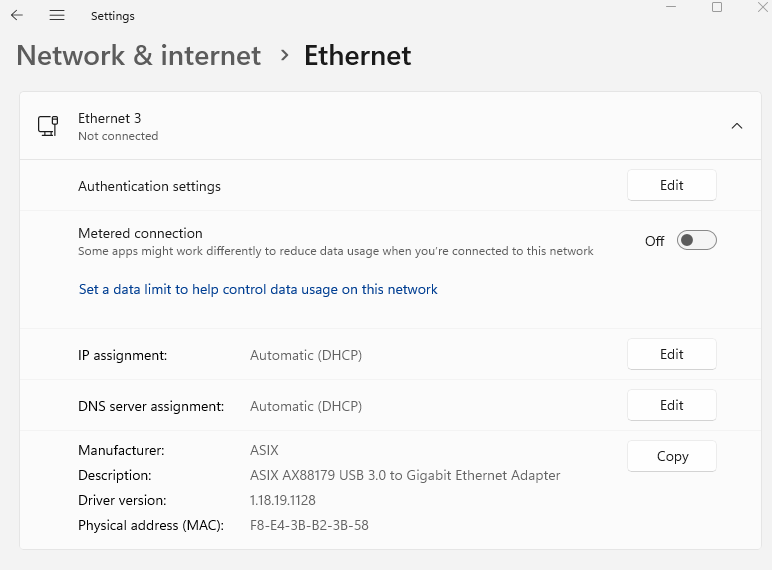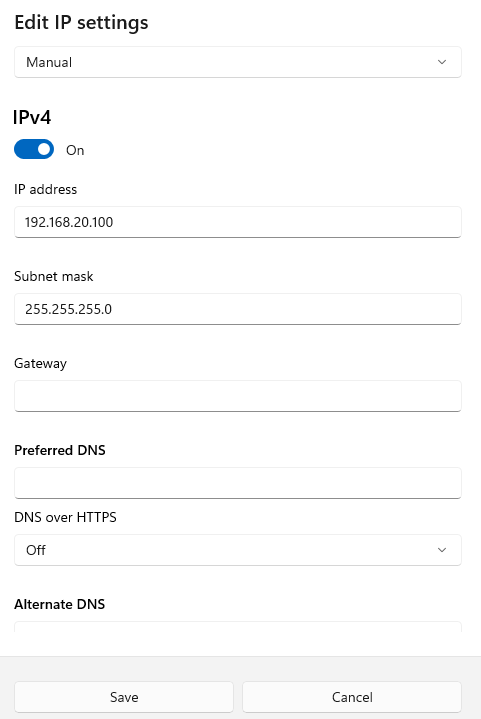Windows API Tools
We have added support for running the API packaged tools on Windows!
⚠️ Currently this process is only tested and confirmed on Windows 11.
Set Up Ethernet Adapter (Static IP)
On your Windows machine, configure your Ethernet interface with a static IP that will be used for connecting to the device. Select Edit on the IP assignment in your ethernet interface’s settings.
Example Settings:
- IP address:
192.168.20.100(This will be<YOUR_WINDOWS_STATIC_IP>below) - Subnet mask:
255.255.255.0 -
Gateway: (Leave blank)
-
Ethernet adapter not connected / interface details

-
Static IP configuration dialog (Manual)

-
Confirmation of manual IP set

You can now ping your device in a PowerShell with:
ping 192.168.20.20
Refer to our Connections Guide for more information on address selection.
Download the Latest voyant-api Tools
-
Download the windows zip folder (
voyant-api-windows-vX.X.X.zip) from voyant-sdk/releases/latest -
Extract the contents and move the files to your desired location.
-
Open a
PowerShelland navigate to the location you moved the files to.cd Path/to/voyant-api-windows-vX.X.X/ -
Verify your installation, by running:
./voyant_hello_world.exeAnd you should see something like:
Welcome to the Voyant Photonics, Inc. API! You have successfully installed the voyant-api package with: - Proto version: 0.2.1 (Proto) - API version: 0.2.1 (API)
Start the sensor
Your Voyant sensor does not start the laser and data stream on boot. Instead, the sensor waits for your command. To start the sensor, simply run:
./voyant_lidar_client.exe --endpoint start
The startup procedure can take ~10 seconds. Upon successful completion, you will see:
✅ LiDAR service started successfully
⚠️ Now that you have started your sensor, be sure to safely stop the sensor before powering the system down when you are done with this tutorial.
More information about starting / stopping your sensor is available at
voyant_lidar_client.
Visualize live sensor data with Foxglove Studio
-
Start the Voyant Foxglove Bridge in your PowerShell by running:
./voyant_foxglove_bridge.exe --bind-addr 0.0.0.0:4444 --group-addr 224.0.0.0 --interface-addr 192.168.20.100If either of these errors are thrown:
> Error: No such device (os error 19) > Error: The requested address is not valid in its context. (os error 10049)please double check your static IP assignment matches the argument you provide to
--interface-addr(192.168.20.100in these instructions).If this doesn’t work, evaluate your networking configuration and reach out to us at Troubleshooting Guide.
More information about the
voyant_foxglove_bridgetool is available at Visualizing Live Sensor Data. -
Open Foxglove Studio in your browser at https://studio.foxglove.dev/ or launch the desktop application if installed.
-
Select
Open connection...in the upper left section of the window to bring up the connection dialog -
In the connection dialog, select “Foxglove WebSocket” as the connection type.
-
Enter the WebSocket URL:
ws://localhost:8765and click “Connect”. -
Download the
config/voyant_foxglove_cfg.jsonfile from thevoyant-sdk/repository.If you have cloned the
voyant-sdk/repo, you already have this file. -
In the layout selector (top right corner), choose “Import from file…” and select the
voyant_foxglove_cfg.json. -
Have some fun looking at your point cloud!
For more detailed Foxglove user instructions, please see our Pointcloud Visualization guide.
Safely stop the sensor
⚠️ Always safely stop the sensor before powering the system down.
To protect the internal components of your sensor, you should disable the lidar stream before powering the system down.
./voyant_lidar_client.exe --endpoint stop
The shutdown procedure can take ~10 seconds. Upon successful completion, you will see:
✅ LiDAR service stopped and system disabled
More information about starting / stopping your sensor is available at
voyant_lidar_client.
✅ Next steps
You are now setup to run the voyant-api through WSL. Please refer to the latter half of the Quickstart Guide to start your sensor, visualize point cloud data, record data, etc.